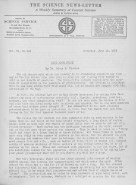Search Results for: Vertebrates
Skip to resultsCan’t find what you’re looking for? Visit our FAQ page.
1,539 results for: Vertebrates
-

-

-

-

-

-

-
 Paleontology
PaleontologyFossils found under tons of Kitty Litter
Excavations at North America's largest Kitter Litter mine have yielded fossils of ancient aquatic reptiles, as well as evidence of a tsunami generated by the extraterrestrial impact that killed off the dinosaurs about 65 million years ago.
By Sid Perkins -
 Paleontology
PaleontologyHow did Triceratops grow its horns?
Newly discovered fossil skulls of juvenile Triceratops may help reveal how the dinosaurs grew their three trademark horns.
By Sid Perkins -
 Paleontology
PaleontologyCT scan unscrambles rare, ancient egg
A tangled heap of bones and bone fragments in the bottom of an unhatched elephant bird egg may soon be reassembled into a model of the long-dead embryo, thanks to high technology—and scientists won't even have to crack open the egg to do it.
By Sid Perkins -
 Paleontology
PaleontologyEven flossing wouldn’t have helped
Small particles trapped in minuscule cracks or pits in the teeth of plant-eating dinosaurs could give scientists a way to identify the types of greenery the ancient herbivores were munching.
By Sid Perkins -
 Paleontology
PaleontologyFossils Indicate. . .Wow, What a Croc!
Newly discovered fossils of an ancient cousin of modern crocodiles suggest that adults of the species may have been dinosaur-munching behemoths that grew to the length of a school bus and weighed as much as 8 metric tons.
By Sid Perkins -
 Health & Medicine
Health & MedicinePuffer Fish Genomes Swim into View
The tightly packed genomes of two puffer fish species have been deciphered.
By John Travis